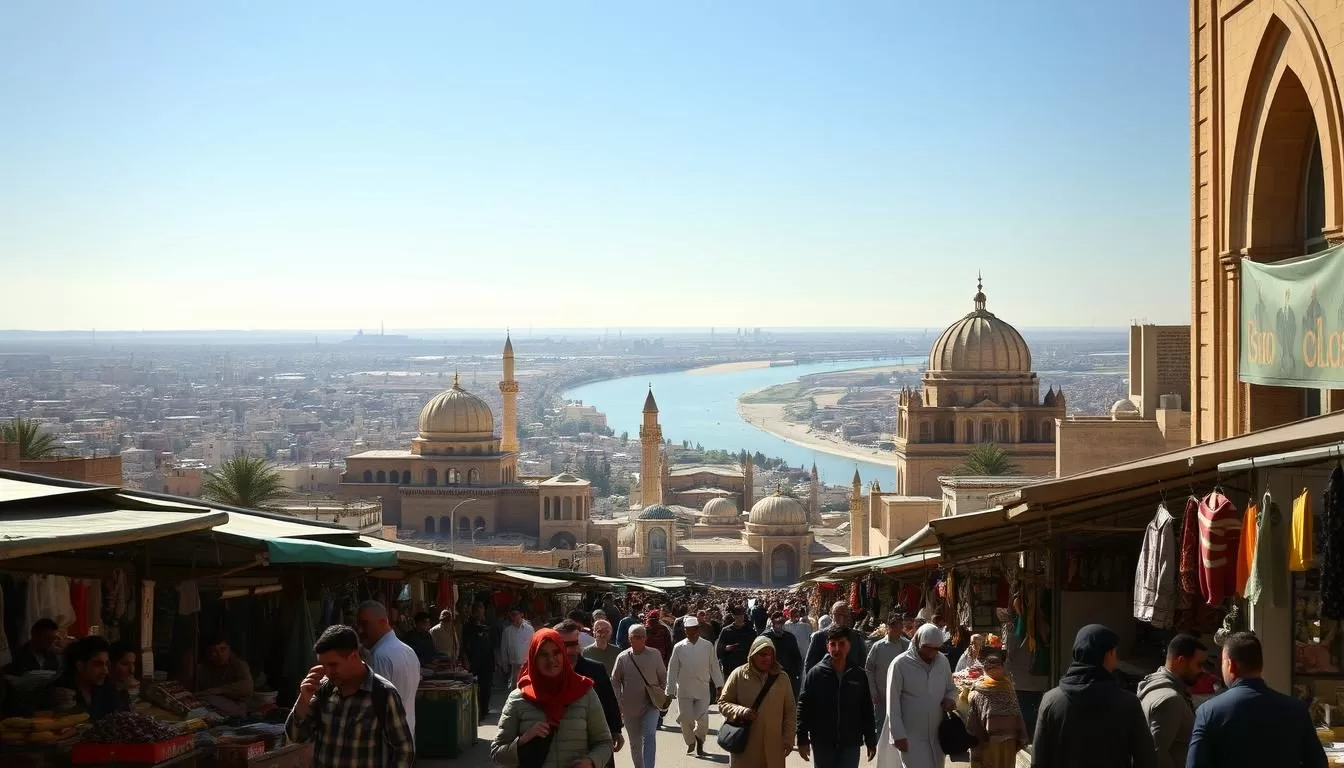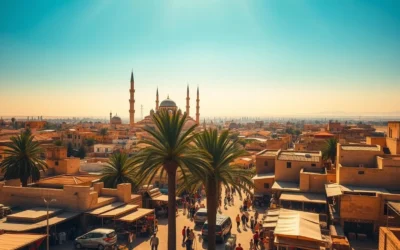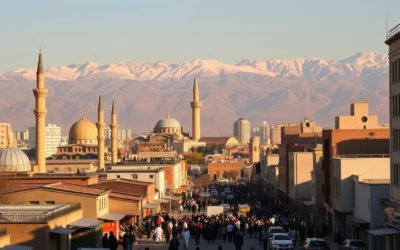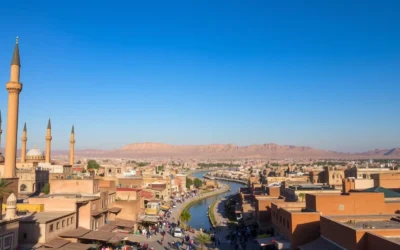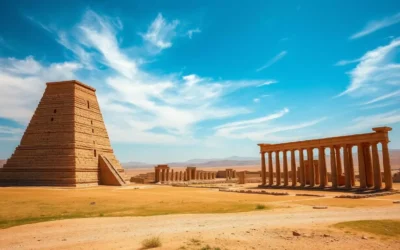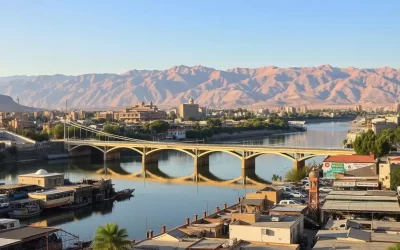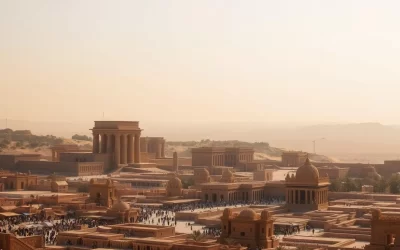✓ Accommodations ✓ Flights ✓ Rental Cars
Welcome to a city that tells a story of revival and resilience. Rising from its past, this vibrant place invites you to explore its rich cultural heritage and modern energy. Whether you’re a history enthusiast or a food lover, there’s something here for every visitor.
From ancient sites to bustling bazaars, this city offers a unique blend of the old and the new. Dive into its history as you wander through its streets, where every corner reveals a piece of its storied past. Don’t miss the chance to savor local food, a true reflection of its life and traditions.
Your trip here will be more than just a tour; it’s an experience that stays with you. Plan your day carefully to make the most of your time in this remarkable place. Whether you’re staying in a cozy hotel or exploring the old city, every moment promises to be unforgettable.
Introduction to Mosul’s Journey of Revival
Step into a city that’s rewriting its story with resilience and hope. Mosul’s tale is one of a place coming back stronger after conflict—a journey highlighted by ongoing restoration and cultural rebirth.
You’ll discover how this region is reviving its proud heritage after years of hardship. The local community’s resilience shines as historical sites are carefully restored. From ancient ruins to iconic landmarks, every corner tells a story of renewal.
“Mosul’s revival is a testament to the strength of its people and their commitment to preserving their history.”
As a tourist, you’ll witness the restoration of the old city, where gates, palaces, and minarets stand as symbols of hope. The building of a brighter future is evident in every experience you’ll have here.
Here’s a quick guide to key sites that showcase Mosul’s revival:
| Landmark | Significance |
|---|---|
| Great Al-Nouri Mosque | Iconic minaret and symbol of resilience |
| Nineveh Ruins | Ancient city with ongoing archaeological work |
| Old City Gates | Historic entrances to the heart of Mosul |
Your travel here will be more than just a visit—it’s a chance to be part of a city’s inspiring journey. Plan your time wisely to explore both the cultural and practical aspects of this remarkable place.
Mosul’s Rich Historical and Cultural Heritage
Uncover the layers of a city shaped by centuries of heritage. From its ancient roots to its modern rebirth, this place offers a unique blend of history and resilience. Every street and building tells a story of a community determined to preserve its legacy.
Tracing the Ancient Legacy
This city has been a vital center since the days of the Assyrian Empire. Its ancient ruins, like the Nineveh site, showcase its historical significance. These landmarks remind us of a time when this place was a hub of culture and power.
Walking through the old city, you’ll encounter gates and structures that have stood for centuries. The architecture reflects the skill and artistry of past generations. It’s a journey through time, offering a view into a world long gone.
Modern Rebirth and Local Resilience
Today, the city is experiencing a cultural rebirth. Restoration projects are breathing new life into its historic sites. The Great Mosque of Al-Nouri, established in the 12th century, is a symbol of this renewal.
The local community plays a key role in this revival. Their efforts ensure that the city’s heritage is preserved for future generations. As you explore, you’ll witness the blend of ancient traditions and modern resilience.
“The city’s revival is a testament to the strength of its people and their commitment to preserving their history.”
Your trip here will be more than just a visit—it’s an experience that connects you to a city’s inspiring journey. Plan your time wisely to explore both the cultural and practical aspects of this remarkable place.
Exploring Ancient Ruins: The Legacy of Nineveh
Discover the remnants of a civilization that shaped world history. Just outside the city, the ancient ruins of Nineveh offer a glimpse into the Assyrian Empire’s past. Restored gateways and walls speak of a once-great capital that rivaled Babylon in size and importance.
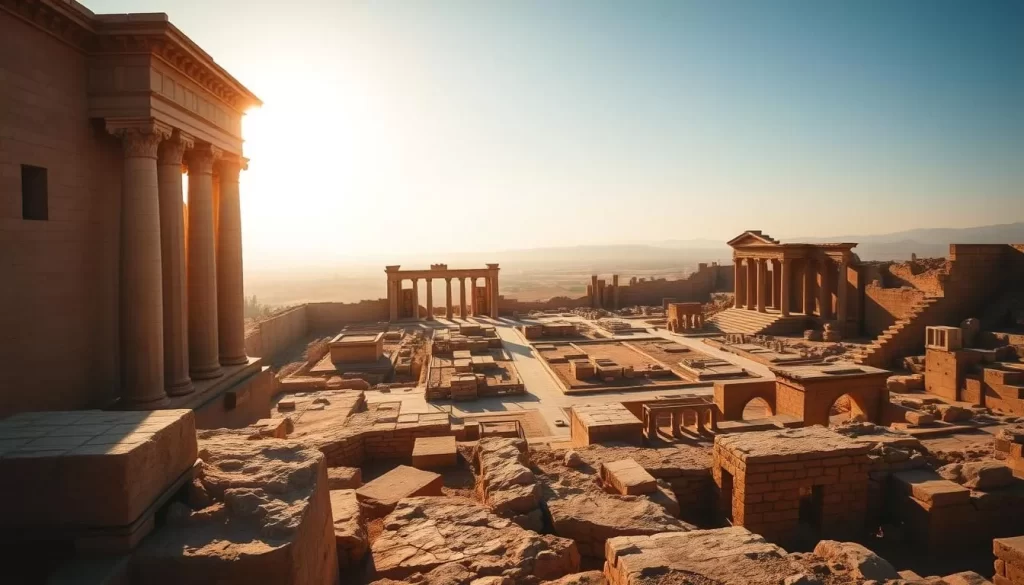
The Historical Significance of Nineveh
Nineveh was the heart of the Assyrian Empire, a city that influenced trade, culture, and politics. Its walls and gates were engineering marvels, protecting a thriving metropolis. Today, these ruins stand as a testament to its historical importance.
As you explore the site, you’ll see how this ancient city played a pivotal role in shaping the region. From its grand palace to its intricate buildings, every stone tells a story of power and innovation.
Archaeological Discoveries and Ongoing Restoration
Modern archaeologists continue to uncover secrets buried for centuries. Recent discoveries include artifacts that shed light on daily life in the Assyrian Empire. These findings are preserved in the museum, offering a deeper understanding of this history.
Restoration projects are breathing new life into the ruins. Teams of experts are rebuilding gates and stabilizing walls, ensuring this site remains accessible for future generations. Their work celebrates the legacy of a city that once ruled an empire.
“Nineveh’s restoration is a bridge between the past and the future, honoring its place in world history.”
Your tour of Nineveh will be a journey through time, connecting you to a civilization that shaped the world. Plan your visit to this remarkable area and witness the ongoing efforts to preserve its majestic legacy.
The Iconic Great Al-Nouri Mosque Complex
Step into a place where history and resilience intertwine. The Great Al-Nouri Mosque Complex stands as a testament to the enduring spirit of its people. This 12th-century architectural marvel, with its iconic leaning minaret, has become a symbol of hope and renewal.
Understanding the Leaning Minaret
The mosque’s leaning minaret, known as Al-Hadba, is a unique feature that has fascinated visitors for centuries. Its tilt, caused by natural factors over time, adds to its charm and historical significance. Standing tall, it offers a breathtaking view of the surrounding area, making it a must-see on your trip.
UNESCO and Restoration Efforts
After years of conflict, the mosque is undergoing a remarkable restoration. Supported by UNESCO, the US, and the UAE, this project aims to revive the shrine to its former glory. The entrance fee is approximately 3,000 IQD or $2 per person, making it accessible for all to witness this historic site.
“The restoration of the Great Al-Nouri Mosque is not just about rebuilding a structure; it’s about reclaiming a piece of our shared history.”
Your visit here will be more than just a tour—it’s an experience that connects you to a city’s inspiring journey. Plan your time wisely to explore this remarkable building and its surrounding area.
Mosul, Iraq: Best Things to Do – Top Picks
Immerse yourself in a city where history and culture come alive. From ancient ruins to vibrant markets, this place offers a mix of experiences that cater to every traveler. Whether you’re exploring historical sites or savoring local food, your trip will be unforgettable.
Start your journey at the Great Al-Nouri Mosque, a symbol of resilience and renewal. Its iconic leaning minaret offers a breathtaking view of the surrounding area. Next, head to the Nineveh Ruins, where you’ll walk through the remnants of an ancient empire that once rivaled Babylon in significance.
Don’t miss the chance to explore the local markets. The Assyrian Market is a bustling hub where you can find everything from spices to handmade crafts. It’s a great way to experience the city’s vibrant culture and meet its friendly people.
For a taste of tradition, try Kubba Mosuli, a dish unique to this region. Made with spiced meat and bulgur wheat, it’s a culinary delight that reflects the city’s rich heritage. Pair it with a cup of tea at Baytna Tea House, a restored spot that showcases the resilience of the local community.
Plan your time wisely to make the most of your visit. Whether you’re staying in a cozy hotel or wandering the streets, every moment here promises to be enriching. Your travel experience will be a blend of discovery and authenticity.
The Old City: A Walk Through Traditional Mosuli Architecture
Take a step back in time as you wander through the historic streets of the Old City. Here, every corner tells a story of resilience and cultural pride. The intricate designs of ornate doorways and restored facades are a testament to the city’s rich heritage.
Ornate Doorways and Historic Facades
As you explore, you’ll notice the detailed craftsmanship of centuries-old architecture. The ornate doorways, with their intricate carvings, are a highlight of the Old City. These facades reflect the skill and artistry of past generations, offering a glimpse into a world long gone.
Many of these historic homes and buildings are now being lovingly restored. This effort preserves the city’s cultural identity and ensures that future generations can appreciate its beauty.
Revitalization of Ancient Streets
The revitalization of the Old City’s streets is a key focus of ongoing restoration projects. Efforts are underway to breathe new life into treasured markets and public spaces. These initiatives aim to create a vibrant atmosphere while honoring the city’s past.
Walking through these streets, you’ll see the blend of ancient traditions and modern resilience. The restored gates and palaces stand as symbols of hope and renewal, inviting you to immerse yourself in the living history of this remarkable site.
“The restoration of the Old City is not just about rebuilding structures; it’s about reclaiming a piece of our shared heritage.”
Your trip here will be more than just a visit—it’s an opportunity to connect with a city’s inspiring journey. Plan your time wisely to explore these historic streets and witness the ongoing efforts to preserve their majestic legacy.
The Sacred Tomb of Prophet Jonah (Nabi Yunus)
Journey to a place where faith and history intertwine. The sacred Tomb of Prophet Jonah, known as Nabi Yunus, is a revered shrine that holds deep spiritual significance. For centuries, this site has been a destination for pilgrims seeking connection and inspiration.
This house of devotion is linked to ancient traditions, reminding visitors of the story of Jonah and his journey. Despite facing destruction, the shrine remains a symbol of resilience and hope. Restoration efforts are underway to preserve this vital piece of spiritual heritage.
Your trip here will be more than just a tour; it’s an opportunity to connect with a story that has inspired millions. The site’s restoration is a testament to the enduring spirit of the city and its people. Plan your day to include this remarkable destination on your travel itinerary.
Here’s a quick guide to key details about the Tomb of Prophet Jonah:
| Aspect | Details |
|---|---|
| Historical Significance | Linked to the story of Jonah and ancient traditions |
| Current Status | Closed for restoration after destruction |
| Restoration Efforts | Supported by international initiatives |
As you explore this sacred way, you’ll witness the convergence of history and spirituality. The Tomb of Prophet Jonah invites you to reflect on its profound legacy and the ongoing efforts to protect it for future generations.
Mosul Museum: Treasures from a Storied Past
Step into a world where history comes alive at the Mosul Museum. This museum houses priceless relics from Assyrian, Roman, and Mesopotamian civilizations, offering you an intimate look into the city’s storied past.
As you explore, you’ll encounter a treasure trove of artifacts that reveal the ancient history of this region. From intricate carvings to monumental statues, each piece tells a story of a bygone era. The museum’s collection includes depictions of Assyrian beasts called lamassu and a stone tablet believed to be the world’s oldest menu.
Despite facing destruction, the museum is undergoing remarkable restoration efforts. The Project Mosul initiative focuses on the recovery of damaged relics through 3D reconstruction based on photographs. Early success has been reported with the partial restoration of The Lion of Mosul, based on initial images received.
“The restoration of the Mosul Museum is not just about rebuilding a structure; it’s about reclaiming a piece of our shared history.”
Your trip here will be more than just a tour; it’s an opportunity to connect with the city’s inspiring journey. Plan your day wisely to explore this remarkable way of understanding the past and present.
Here’s a quick guide to key details about the Mosul Museum:
| Aspect | Details |
|---|---|
| Historical Significance | Houses relics from Assyrian, Roman, and Mesopotamian civilizations |
| Restoration Efforts | Supported by Project Mosul and international initiatives |
| Key Exhibits | Lamassu statues, ancient stone tablet, and The Lion of Mosul |
As you walk through the museum, you’ll witness the convergence of history and resilience. The Mosul Museum invites you to reflect on its profound legacy and the ongoing efforts to protect it for future generations.
Tigris River Experiences and Scenic Walks
Experience the serene beauty of the Tigris River as it winds through the heart of the city. A stroll along its banks at sunset offers breathtaking views and a unique perspective of the skyline, blending the past and present.
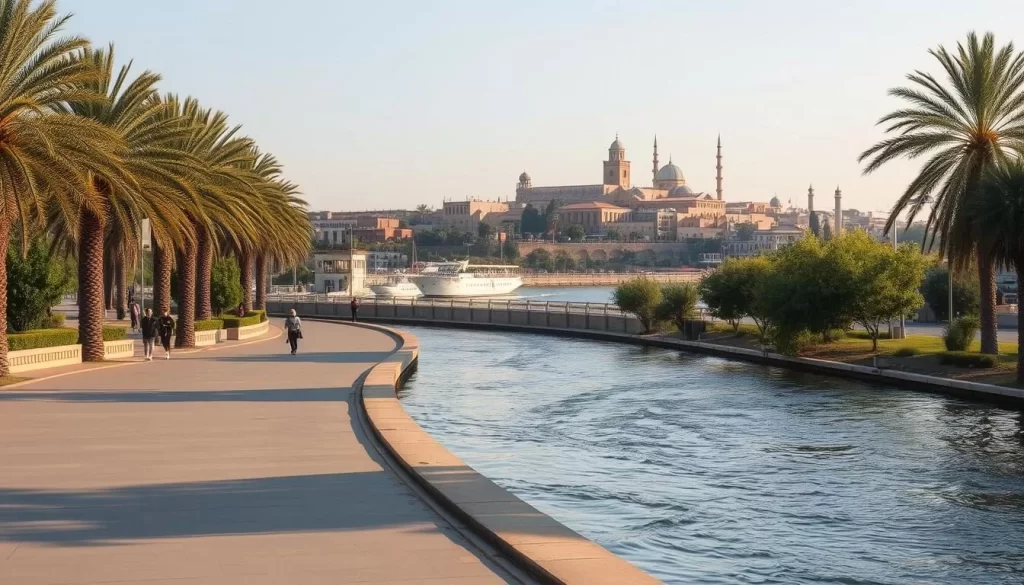
Walking along the waterfront, you’ll find picturesque spots perfect for relaxation. The river’s calm waters reflect the city’s resilience, creating a peaceful atmosphere. It’s a great way to unwind after a busy day of exploring.
Strolling Along the Waterfront
Take your time to enjoy the scenic paths that line the Tigris River. These walks are ideal for soaking in the natural beauty and historical charm of the area. You’ll pass by ancient ruins and modern landmarks, offering a glimpse into the world of contrasts.
For a more immersive experience, consider a boat tour. These rides provide stunning views of the city’s skyline and are an affordable way to see the area from a different perspective.
Local cafes and eateries near the river add to the pleasant experience. Enjoy a cup of tea or a traditional meal while taking in the views. It’s a perfect way to end your day in this remarkable place.
Here’s a quick guide to making the most of your Tigris River experience:
| Activity | Details |
|---|---|
| Scenic Walks | Explore the serene paths along the riverbanks |
| Boat Tours | Affordable rides offering stunning skyline views |
| Local Cafes | Enjoy traditional meals with a riverside view |
For more tips on exploring the region, check out this guide to independent travel in Iraq.
Savoring Mosul’s Culinary Delights
Dive into the rich flavors of a city that has mastered the art of blending tradition with taste. Here, every meal tells a story of resilience and cultural pride, offering a culinary journey influenced by Kurdish, Arabic, and Assyrian traditions.
Start your trip with Kubba Mosuli, a dish that has delighted locals for generations. Made with spiced meat and bulgur wheat, it’s a flavorful representation of the region’s heritage. Pair it with Masgouf, a grilled fish dish that’s a staple in this place.
For a sweet treat, try Kahi Geymar, a pastry filled with creamy clotted cream. It’s a perfect way to end your day of culinary exploration. Each bite offers a taste of the city’s rich history and modern creativity.
Where to Eat: Hidden Gems and Local Favorites
Discover top local restaurants and street food stalls that bring these dishes to life. From cozy hotels to bustling markets, every place offers a unique dining experience. Don’t miss the chance to chat with locals, who are always eager to share their favorite spots.
“The flavors of Mosul are a testament to its rich cultural tapestry, blending ancient traditions with modern innovation.”
To make the most of your travel, plan your time wisely. Start your day with a hearty breakfast, explore the markets for lunch, and end with a memorable dinner. Whether you’re a seasoned foodie or a curious traveler, this culinary adventure will leave you inspired.
For more insights into the region’s history, explore the writings of a medieval Christian pilgrim, who documented his encounters with the local culture and traditions.
Exploring Local Bazaars and the Assyrian Market
Step into the vibrant heart of the city’s trade and culture at its bustling bazaars. These markets are a treasure trove of traditional crafts, spices, and goods, offering a glimpse into the daily life of the region. From colorful displays to friendly vendors, every corner invites you to explore and discover.
One of the highlights is the famed Assyrian Market, where you’ll find handmade crafts and unique souvenirs. This place is not just a shopping destination; it’s a cultural experience. The market’s lively atmosphere reflects the resilience and creativity of the local community.
Haggling is an art here, and mastering it can lead to great deals. Don’t be shy to negotiate with vendors—it’s part of the fun. Whether you’re looking for spices, textiles, or jewelry, the bazaars offer something for every visitor.
These markets play a vital role in the city’s everyday life. They are hubs of social interaction and economic activity, connecting people from all walks of life. Your visit here will give you a deeper understanding of the area’s rich traditions and modern vitality.
Here’s a quick guide to making the most of your time in the bazaars:
- Start early to avoid the midday crowds.
- Bring cash, as many vendors don’t accept cards.
- Engage with locals to learn about their favorite stalls.
Your trip to these markets will be more than just a shopping spree—it’s a chance to immerse yourself in the world of a vibrant and resilient city. Plan your day wisely to explore every corner and take home memories that last a lifetime.
Cultural Festivals and Art in Mosul
Discover a city where art and culture flourish in every corner. From inspiring art centers to vibrant festivals, this place celebrates its rich heritage and modern creativity. Whether you’re a tourist or a local, the cultural scene here offers something for everyone.
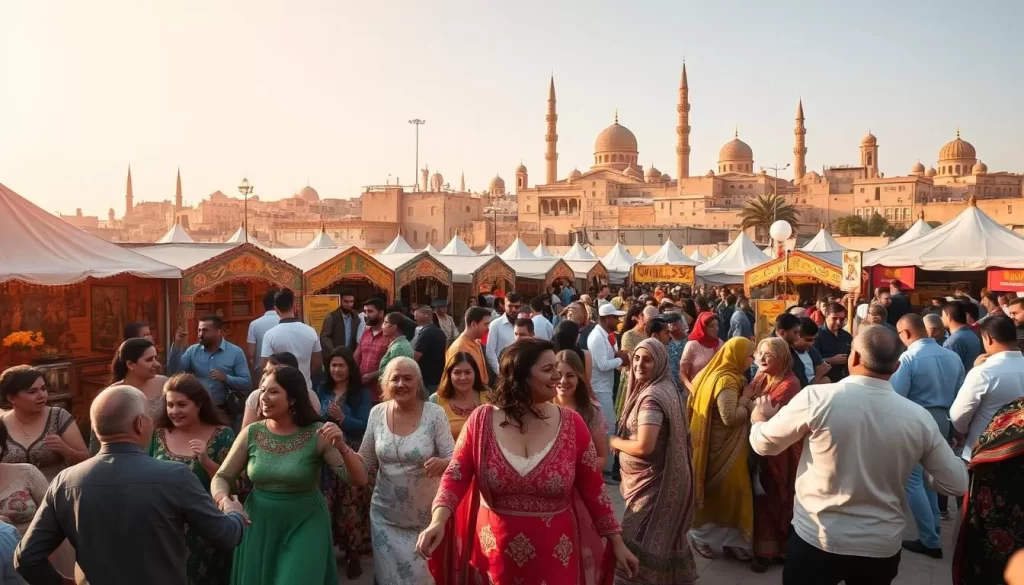
Baytna Art Center and Local Exhibitions
The Baytna Art Center stands as a symbol of the city’s revival. This hub of creativity showcases local talent through exhibitions and workshops. It’s a place where artists gather to share their stories and inspire the community.
Local exhibitions here highlight the diversity of artistic expressions. From traditional crafts to contemporary art, each piece reflects the region’s unique identity. These events are not just about art; they’re about reclaiming the city’s cultural legacy.
Festivals That Light Up the City
Annual festivals bring the city to life with music, dance, and theater. These events celebrate both ancient traditions and modern creativity. They’re a testament to the resilience and spirit of the local community.
One of the highlights is the Basra Festival of Culture and Arts. This event showcases local talent through performances and exhibitions. It’s a day filled with joy and inspiration, drawing visitors from across the region.
“Art and culture are the heart of our city’s revival, connecting us to our past and inspiring our future.”
Here’s a quick guide to key cultural events in the city:
| Event | Details |
|---|---|
| Baytna Art Center Exhibitions | Showcases local talent and diverse art forms |
| Basra Festival of Culture and Arts | Annual event featuring music, dance, and theater |
| Nowruz Celebrations | Persian New Year marked by the Kurdish population |
Your day exploring the art scene will be more than just a visit—it’s an opportunity to connect with the city’s inspiring journey. Plan your time wisely to experience the creativity and resilience that define this remarkable place.
Experiencing Modern Mosul: Safety and Travel Tips
Exploring a city in the midst of revival offers a unique blend of history and modernity. As a tourist, you’ll find practical advice on staying safe and navigating this remarkable place, ensuring your day is as enriching as it is secure.
Start by planning your day carefully. Visit key sites like the Great Al-Nouri Mosque and the Nineveh Ruins early to avoid crowds. These landmarks showcase the city’s resilience and cultural heritage.
For accommodations, consider staying in a hotel that offers both comfort and security. Prices in the region range from 20,000 IQD to 40,000 IQD per night, ensuring options for every budget.
When it comes to food, savor local dishes like Kubba Mosuli and Masgouf. These meals are not only delicious but also a reflection of the city’s rich traditions. Local meal prices range from 1,000 IQD to 8,000 IQD, making dining affordable.
Transportation is another key aspect of your visit. Taxi rides within the city cost between 3,000 IQD and 7,000 IQD, while intercity transport ranges from 2,000 IQD to 25,000 IQD depending on distance.
Here’s a quick guide to help you plan your visit:
| Aspect | Details |
|---|---|
| Accommodation | 20,000 IQD to 40,000 IQD per night |
| Local Meals | 1,000 IQD to 8,000 IQD |
| Transportation | 3,000 IQD to 25,000 IQD |
| Key Sites | Great Al-Nouri Mosque, Nineveh Ruins |
For more insights into the region’s history, explore the writings of a medieval Christian pilgrim, who documented his encounters with the local culture and traditions.
Your visit to this place will be more than just a trip—it’s an opportunity to connect with a city’s inspiring journey. Plan your day wisely to explore every corner and take home memories that last a lifetime.
Practical Tips for Visiting Mosul
Prepare for an unforgettable journey with essential tips for your visit. Whether you’re planning your first trip or returning to explore more, these insights will help you navigate the city with ease. From the best times to travel to where to stay, we’ve got you covered.
Best Times to Explore
The ideal months to visit are April, May, September, and October. These periods offer pleasant weather, perfect for exploring historical sites and vibrant markets. Avoid the summer months, as temperatures can exceed 100 degrees Fahrenheit, making outdoor activities challenging.
Plan your day around the opening hours of tourist attractions, which typically close by 3 PM. Markets, however, come alive in the evening, offering a lively atmosphere for shopping and dining.
Getting There and Accommodation Options
Reaching the city is straightforward. Shared taxis from Baghdad cost around 25,000 IQD ($16), while minibus fares to Erbil are approximately 5,000 IQD ($3.50) per person. For a more comfortable journey, consider private taxis or airport shuttles.
Accommodation options range from modern hotels to traditional guesthouses. Prices for a two-person room typically range from $17 to $40 per night, ensuring options for every budget. Staying in a centrally located hotel makes it easier to explore key attractions like the Great Al-Nouri mosque and Nineveh Ruins.
Here’s a quick guide to help you plan your trip:
| Aspect | Details |
|---|---|
| Best Months to Visit | April, May, September, October |
| Transport Options | Shared taxis, minibuses, private taxis |
| Accommodation Prices | $17 to $40 per night |
| Key Attractions | Great Al-Nouri Mosque, Nineveh Ruins |
For more tips on exploring the region, check out this guide to backpacking in Iraq. Your journey to this remarkable place will be enriched with these practical insights, ensuring a smooth and memorable experience.
Stories of Local Resilience and Community Spirit
Witness the unwavering spirit of a community that has turned adversity into strength. In this city, every story is a testament to hope and renewal. From rebuilding homes to restoring cultural landmarks, the people here have shown an indomitable will to thrive.
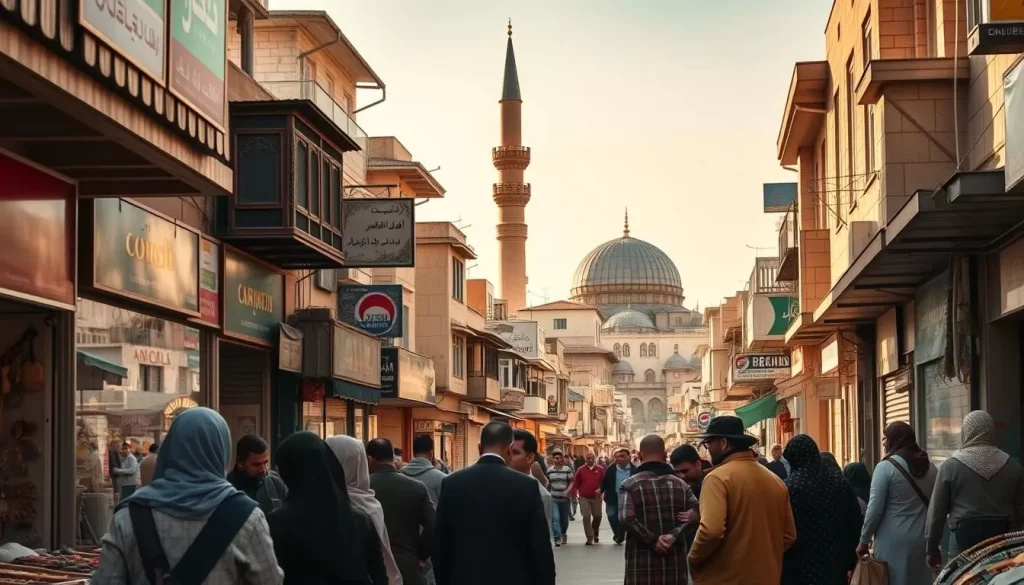
One inspiring example is the restoration of the Great Al-Nouri mosque, a symbol of the city’s resilience. Locals have worked tirelessly to bring this historic site back to life, proving that even in the face of destruction, hope prevails.
Personal anecdotes from residents reveal the heart of this place. Many have rebuilt their homes and businesses, creating a renewed sense of community. Their stories remind us that resilience is not just about survival but about thriving against all odds.
“The strength of our community lies in our ability to come together and rebuild, no matter the challenges we face.”
Youth initiatives have also played a crucial role in this revival. Programs like the Diploma for Peace and Conflict Studies have empowered young people to lead change, fostering a culture of unity and progress.
Here’s how you can connect with this inspiring journey:
- Engage with locals to hear their stories firsthand.
- Visit restored sites like the Great Al-Nouri mosque to witness the results of their efforts.
- Support community projects that continue to drive renewal.
For a deeper understanding of the impact of resilience, explore this story of young Iraqis who have turned hardship into hope. Your visit to this remarkable place will not only be a journey through history but also a connection to the heartbeat of its people.
Conclusion
As you reflect on your journey through this remarkable place, you’ll find a city that blends history, culture, and resilience in every corner. From ancient ruins to vibrant markets, every step reveals a story of revival and hope. This place invites you to be part of its inspiring transformation.
Your day here will be filled with discoveries, whether you’re exploring historic sites or savoring local flavors. The city’s restoration efforts, like the Great Al-Nouri Mosque, showcase its unwavering spirit. Staying in a cozy hotel or wandering through the Old City, you’ll witness the harmony of past and present.
This place is more than a destination; it’s a testament to human resilience. By visiting, you support its cultural renaissance and contribute to its future. Plan your day carefully to experience every facet of this transformative city.
For more insights into the capital’s revival, explore the key players in its journey. Your visit will not only enrich your understanding but also leave you inspired by the strength of this remarkable place.
The above is subject to change.
Check back often to TRAVEL.COM for the latest travel tips and deals.
